Reggie Cabral bought the first landscape painting Hilda Neily sold in Provincetown over 50 years ago with $100 worth of bar change. Cabral, who owned the Atlantic House from 1949 until his death in 1996, was always surrounded by local artists, writers, and offbeat types. It was 1968, the year Neily moved to Provincetown.
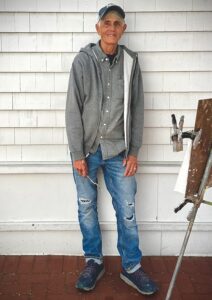
She is standing on Johnson Street, her easel positioned at a slight angle, facing away from the water and toward the fire station. The midmorning light hits the harbor-facing sides of houses, fences, mailboxes, shrubs, and chimneys.
Squint your eyes on a sunny day and take note of the colors around you. This is a glimpse into Hilda Neily’s perspective. She’s so captivated by color and light that she has trouble driving. Her wife, Catherine, takes the wheel while Neily scans the clouds from the passenger seat.
“If you get the color right, you’ll get the value right,” Neily says. She is beginning her painting, blocking in color. It takes time, but she’s quick with her diamond-shaped palette knife, a Loew-Cornell. “You can’t find them anymore,” she says. Each note on the Masonite board sounds like the snip of a barber’s scissors.
Neily was born in 1947 and grew up in Windsor, Vt. The library was the only place Neily was allowed to go alone as a child. That’s where she saw the dreamy, ethereal paintings of Maxfield Parrish, who spent time in Windsor. Two huge Parrish paintings hung on each side of the library’s fireplace, she says. “I’d sit and look at them. To me, as a child, that’s what a painting was, because I hadn’t seen anything else.”
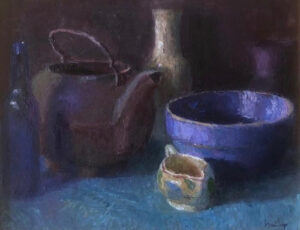
Neily, who paints only in natural light, had arrived on Johnson Street to scope her spot this morning at 8 o’clock. Her practice requires focus and precision. She doesn’t like it when passersby look over her shoulder. “Please don’t watch me paint,” she’ll say to onlookers.
The smell of oil paint from Neily’s palette fills the small patio where she’s painting, which is outside a Pilates studio. The instructor’s voice blares from a speaker, but Neily is unfazed. She commands her own quiet.
She graduated from the Art Institute of Boston in 1968. She lived in Cambridge, making art and trying to get her style right. “I wasn’t doing what I wanted to do,” she says. Then someone told her that people sold art in Provincetown. Neily hopped on a bus, stayed at a friend’s house for a day, and found a job doing repairs and maintenance at Angel’s Landing. “I was a handyman all over town,” she says. “I’m wicked mechanically inclined.”
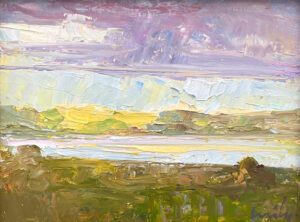
Early on, Neily wasn’t sure about her artistic direction. But her girlfriend saw an article in the newspaper about an artist teaching landscape painting. That artist was Henry Hensche, who had founded the Cape School of Art in 1932. When Neily called Hensche, he told her he had a long beard and lived in a cave. “He was trying to make me think he was scary,” she says. She studied with him for 15 years.
Neily’s use of white brightens her work; deeper colors are relegated to the shadows. She creates distance with color. “We don’t use black,” she says, referring to the practice among artists at the school. She paints what she sees — “You can’t always try and figure it out because then you go along making rules about it,” she says.
Neily’s vivid palette shows up in Heat. In the painting, the structure of the cottages plays second fiddle to the light they reflect. It’s all color — Neily has dragged streams of orange sunlight across her work. The painting bears a resemblance to works by Hensche, who stressed color and played with highlights.
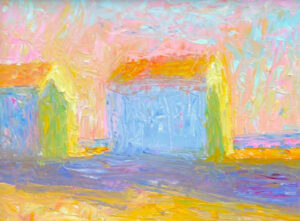
Hensche would allow Neily into his studio on Pearl Street. There, she would sit and watch him paint for hours. More than in classes, she says, “that’s how I learned — Henry gave me the greatest gift because he taught me how to see color.”
For a time, Neily sold her work at the Ellen Harris Gallery (which closed after Harris died in 1997). But soon she opened her own gallery. George Hitchcock, who worked for Donald V. Edwards at the Governor Bradford, helped her get started, she says. “He picked me up in his big old open Jeep and took me to get insurance.” Then he brought her to town hall to get a license.

Edwards rented her a space in the back alley across from the hardware store, where the Pilgrim House is now. She traded him paintings for rent. Artist Midge Battelle worked the gallery and sold her photographs while Neily painted plein air in the landscape. That’s when people started buying her work, she says. She moved her gallery to 354 Commercial St. in 2010. There, another restaurant-owning art collector, Anton “Napi” Van Dereck owned the building. “Napi gave us affordable rent,” she says.
Neily’s painting Good Morning depicts a grassy lane that leads to the water in Provincetown’s West End. She has applied thick oil paint with her knife, but even so, she manages to show details like vines crawling up the side of a house. The work is in the Cape School of Art’s auction, which is underway now. The sales will support the school, which Neily, along with Rob Longley, who had also been a student of Hensche, reestablished in 2010.
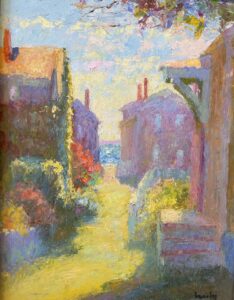
“One thing I’d like to do before I croak,” Neily says, “is see the Cape School have its own home.” The school rents a space off Route 6 from businessman Patrick Patrick. “He’s been so good to us, but I’d really like the school to have its own home.”
She steps away from her easel. “We’re the oldest school in town,” she says. Neily notices the light has changed on Johnson Street. The shadows are beginning to shift. She picks up her easel, nods a goodbye, and walks away.
Old School
The event: Cape School of Art Auction
The time: Through Oct. 5; closing reception Saturday, Oct. 5, 6 to 9 p.m.
The place: Auction online; closing reception at Seashore Point, 100 Alden St., Provincetown
The cost: Browsing is free



